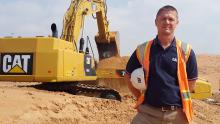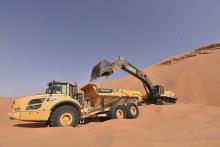Despite the slump in oil revenues there are still many infrastructure projects underway in the Middle East.
Guy Woodford reports on trends in the region.
Dubai is home to one of the latest attention-grabbing Middle East infrastructure megaprojects: a 3.2km waterway through downtown Dubai due to open this year.
[caption id="attachment_84161" align="alignright" width="462"] Gary Martin, Caterpillar's Middle East & Africa heavy construction & quarrying application specialist, believes Middle East aggregate demand is being adversely affected by government payment policies, low oil prices and a lack of international investment[/caption]
Gary Martin, Caterpillar's Middle East & Africa heavy construction & quarrying application specialist, believes Middle East aggregate demand is being adversely affected by government payment policies, low oil prices and a lack of international investment[/caption]
The $544m canal is reportedly progressing at breakneck speed. Dubai is an Emirate within the United Arab Emirates, which, when combined with the Gulf countries, is one of three distinct markets in the Middle East region, with Saudi Arabia and Iran completing the trio.
Global aggregates production analysis by the European Aggregates Association states that the Middle East accounts for 4% of the 50 billion tonnes of aggregates produced globally in 2015.
The region’s production output is the same as Russia/CIS and Oceania, and one billion tonnes less a year than the USA and Europe. China is the biggest aggregate producer in the world – accounting for 40% (20 billion tonnes) of output in 2015.
Building materials players LafargeHolcim and Cemex, have a strong presence in the Middle East regional market.
LafargeHolcim’s Q3 2016 Interim Report states how countries in the Middle East made positive contributions to the building materials giant’s growth. In Iraq, more favourable market conditions were said to have helped to drive improved performance compared to the same period of 2015.
Saudi Arabia is the world’s biggest oil exporter and the largest economy in the Arab region, but a dramatic slump in oil revenues led to a record Saudi budget deficit of $97bn in 2016. Efforts are being made to address this, including the Saudi government’s January 2017 agreement to allow an IMF-backed value-added tax to be imposed across the Gulf, ending the region’s much publicised tax-free living.
[caption id="attachment_84165" align="alignleft" width="462"] A Caterpillar 772G RDT loaded by a 374D excavator at a quarry in the UAE[/caption]
A Caterpillar 772G RDT loaded by a 374D excavator at a quarry in the UAE[/caption]
Despite its huge budget deficit issue, the growth of Saudi Arabia’s population alone dictates that huge sums still need to be spent on new residential construction and transport infrastructure.
According to the United Nations Department of Economic and Social Affairs (UNDESA), Saudi Arabia’s population is forecast to increase by 30.7% between 2010 and 2030.
Timetric, an industry research firm, is forecasting growth, although not risk-free due to oil prices and other factors, such as regional conflicts, in the Saudi Arabian construction industry. According to its Construction in Saudi Arabia -Key Trends and Opportunities to 2020 report, the country’s construction industry will rise in value from $105.6bn in 2015 to $148.5bn in 2020, measured at constant 2010 US dollar exchange rates.
The growth, Timetric says, will be supported by increased government participation and investments in sectors such as healthcare, education and infrastructure construction to diversify the country’s economy away from the depressed oil sector.
The Saudi Arabian government’s White Land Tax initiative to address the country’s housing shortage will also support industry growth, Timetric says. Examples of the scores of Saudi Arabian infrastructure megaprojects, each worth at least $1 billion, reportedly underway or planned for completion by 2030, include the Riyadh Metro costing $22.5bn and earmarked for completion by 2020. With 176km of line and 80 stations, it is the biggest project of its type in the world.
Qatar and Kuwait are among the Gulf countries with growing construction sectors and, as such, boast strong aggregate demand. Qatar’s construction growth is being driven by the National Vision 2030 – the country’s economic diversification policy – and football, in the shape of its preparations for the 2022 FIFA World Cup. Kuwait’s delivery of key infrastructure projects and investment in healthcare, educational facilities and new housing projects will, says Timetric, contribute to the future growth of the nation’s construction industry. The country’s Vision 2035, under which the government aims to develop the country’s road, rail, airport and related infrastructure, is also expected to drive construction equipment demand.
The lifting of nuclear weapon capability-related economic sanctions on Iran in January 2016 may have unlocked project investments worth up to $200bn, but, as Timetric points out, there are certain risks associated with Iran’s construction industry outlook, most notably low oil prices, high labour costs, corruption and political instability. Falling oil prices are also expected to affect Iranian government earnings from oil exports. Despite this, with national aggregate demand of at least 250 million tonnes/year, it’s a market still keenly eyed by aggregate producers
Indeed, the construction market in Iran in 2016 was worth more than $154bn, according to the Italy-based Samoter-Veronafiere Observatory. The same source reports a full-scale boom in residential building: out of more than 15 million Iranian families, 70% aim to be home-owners for a total of 13.5m residential units, while demand in the future is around 750 thousand new homes/year.
Iran was in the limelight at the Verona Exhibition Centre with 15 important buyers and as the guest country of the 30th edition of Samoter, the triennial exhibition dedicated to earthmoving, site and building machinery staged in Verona, Italy earlier this year. During the exhibition, a delegation from the Middle East country received the Samoter International Award for ‘considerable impulse given to sector development’.
The Samoter-Veronafiere Observatory and Euro Orient Expo, a company based in Italy and Iran providing a wide range of specific services especially tailored for SMEs looking to invest in the Iranian market, say that over and above major national projects such as the expansion of the railway and motorway networks and the modernisation of Qeshm and Kish Airports, there will need to be significant renovation investments in the private real estate sector.
It is estimated that more than 14,000sq metres of buildings will require safety work to meet regulations, since 50% of homes are more than 30 years old and the entire country is exposed to high earthquake risks. There is consequently strong demand for earthmoving and excavation machinery as well as cranes, prefabricated buildings, ‘green’ solutions and anti-seismic products.
Caterpillar, the world’s biggest selling construction equipment manufacturer, is a long-established trader in the Middle East region. Gary Martin, Cat's Middle East & Africa heavy construction & quarrying application specialist, says the demand for equipment in the Middle East is down due to a number of factors: government payment policies, low oil prices and the lack of international investment. "Heavy construction contractors are incurring more risks as payment from governments is being withheld for longer periods. After the downturn of 2008, construction and quarrying spiked again between 2011 and 2013. Today, as companies struggle to stay afloat and sometimes even to pay their staff on time, every dollar counts,” says Martin.
“With less construction projects awarded, the competition between the aggregate suppliers has grown more intense. In addition, a new tax of around US$2 is now levied in the UAE for every tonne that leaves the quarry by road," he says.
"Equipment purchase can represent around 35% of the actual cost of a heavy construction project or even of the cost per tonne for a quarry. Some customers solely purchase their equipment based on the initial equipment cost, whilst others take the long-term view and take into account the total owning and operating costs.”
Martin says equipment for Qatar is currently less than 40% of what it was two years ago. He says a lot of work has yet to be completed in readiness for the 2022 World Cup and Caterpillar anticipates that equipment demand will increase within the next twelve months.
Turning his attention to the UAE, Martin says there has been much excitement about the vast expansion of the Al Maktoum international airport in the UAE. The airport will benefit from four new runways and more terminal space by 2020.
“The Gulf Railway project which will link the six Gulf Cooperation Council member states hasn’t materialised yet,” adds Martin. “Bids are now open for the major contracts for the 2020 Expo and work is expected to start before the end of 2017. Another $4.6bn is reportedly to be awarded.
“Oman has also just started to award $220m worth of road construction, dam and port projects without major international investment, unlike some of its neighbours.”
Martin points to Saudi Arabia’s good times from 2008 until 2015 when oil demand and price were at their highest. As stated earlier in this Market Report, oil revenues fell in 2015 and again in 2016, with the Saudi government cutting public spending and halting a number of investment projects. However, moving forward, Martin is encouraged by the Saudis renewed focus on infrastructure and transport.
“Expenditure is set to grow from SAR 31 billion ($8.26bn) in 2016 to SAR 52 billion ($13.85bn) in 2017. This funding will in part be used to settle delayed payments for projects that are already in progress. In 2008, to keep prices down and fulfil local government-funded infrastructure projects, Saudi Arabia imposed a ban on cement export. The export ban will be lifted during 2017 which is good news for Qatar, the main importer of Saudi cement, which needs to complete its projects in preparation for the 2022 World Cup. According to official data, Qatar will require an estimated 57,000,000 tonnes of cement before 2022.”
With governmental funding delayed, Martin says projects take longer to mature, but contractors still need to complete on time. “As a result, we have seen demand spikes for highly productive models such as our Cat 966H wheel loader, 374F excavator, 745C articulated truck, 14L motor grader and dozers from D8R to D9R. These are very popular with contractors and quarry customers as they require low operating costs and flexibility for a maximum return, to survive.”
Martin says the past five years have seen a slow shift, mainly in Qatar and the UAE, towards implementing environmental credits within the bidding process for major governmental projects, as is common practice in Europe.
Luis Santos, senior vice president for Africa, Middle East and Turkey at Metso Mining and Construction, says competition between Middle East aggregate producers has intensified in the last year, with Saudi Arabia – the region’s biggest national market – seeing its aggregate demand deteriorate even further, mainly due to plummeting oil prices.
However, Santos believes that the end of 2017 into early 2018 will see the start of the recovery in aggregate demand across the whole of the Middle East. “From a product standpoint, the aggregate producers are using more and more stationary modular plants (crushing and screening). Some countries are also opting for mobile units,” Santos says.
“The biggest issue in the region is finding ways to significantly lower aggregate-based operational costs. This is driving investment in simple and automated solutions, such as Metso’s latest automated products, including Metso Metrics and IC automation packages. In spite of their lower energy bill, most of the existing [Middle East] quarries still operate with high costs, even higher than in the EU," he says.
Santos does not foresee major changes in aggregate demand in the Middle East for the next 5 years. “Let’s see developments in KSA [Kingdom of Saudi Arabia] as well as the market changes in Iran. Those two countries may make Middle East aggregate market growth a bit more aggressive.”
First published in Aggregates Business Europe









